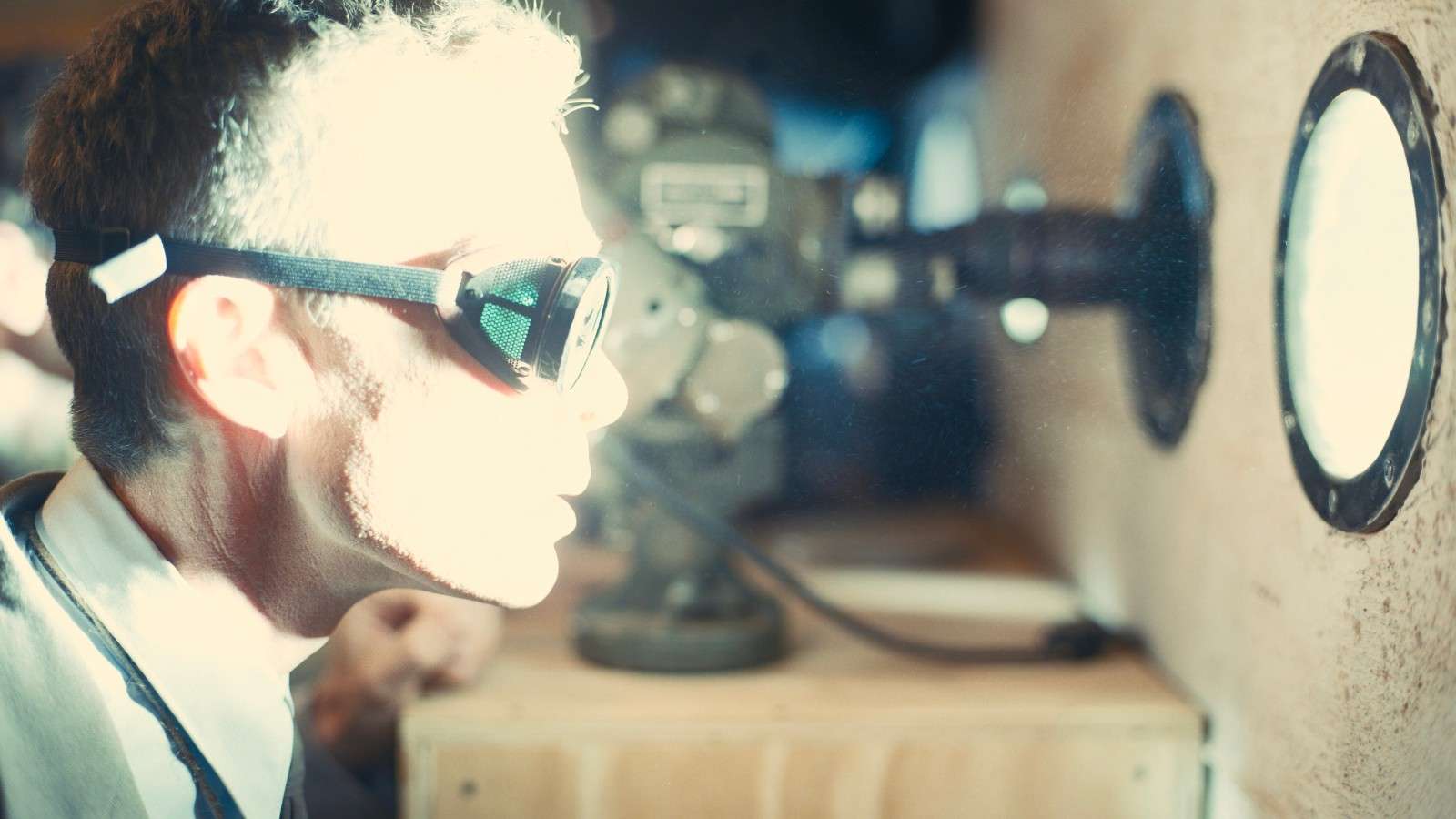Best way to watch Oppenheimer: IMAX & PLF explained
 Universal Pictures
Universal PicturesOppenheimer, Christopher Nolan’s smash-hit atomic bomb drama, is still in cinemas – so, whether it’s IMAX 70mm, Dolby Cinema, or other Premium Large Formats (PLFs), here’s the best way to watch the movie.
The backend of an 18-wheeler lorry jolting into the air and flipping onto the road, Paris’ baroque cityscape bending into the sky, an audacious mid-air takeover and destruction of a plane, the spinning silhouette of a spacecraft surrounded by rubble atop the ice-white atmosphere of a faraway planet: these are some of the most jaw-dropping, awe-inspiring sights in Nolan’s filmography, and all of them were enhanced by the power of IMAX.
After the immersive air-land-and-sea warfare of Dunkirk and brain-breaking ex/implosions of Tenet, Oppenheimer looks to be another epic leap forward: a “horror” movie about the “most important man who ever lived”, with the mighty selling point of a recreated nuke without CGI.
You can read our review of the movie here. While perhaps more so than ever before, it’s imperative that you seek out the best, biggest screen you can find for Oppenheimer, so here’s a rundown on the best way to watch it.
Best way to watch Oppenheimer: The simple answer
You should watch Oppenheimer in IMAX 70mm if you can.
This is because the movie is designed for this specific format, with Nolan ensuring that this presentation will expand images up to a 1.43:1 aspect ratio. In his own words, as per AP, it’s the “best possible experience” to view the film.
To be clear, not every IMAX theater offers 70mm (we’ll list all of the venues in a bit); in fact, only 25 cinemas across the US are capable of it. So, what should you do instead?
You should seek out any PLF screen, whether it’s an ordinary IMAX theater, Dolby Cinemas, or formats specific to each theater. Dolby Cinemas offer HDR and Dolby Atmos sound, which some believe to be superior to IMAX sound systems.
Nolan is sending out more than 100 70mm prints across the world, and they’re a “fabulous presentation… the two formats are sort of different and I love them both.”
Best way to watch Oppenheimer: All IMAX 70mm theaters
You can find a complete list of IMAX 70mm theaters in the US and elsewhere below:
US:
- Harkins Arizona Mills 25 & IMAX – Tempe, AZ
- AMC Metreon 16 & IMAX – San Francisco, CA
- Universal Cinema AMC at CityWalk Hollywood & IMAX – Universal City, CA
- TCL Chinese Theater IMAX – Hollywood CA
- Regal Edwards Ontario Palace & IMAX – Ontario, CA
- Regal Irvine Spectrum 21 + IMAX – Irvine CA
- Esquire IMAX – Sacramento, CA
- Regal Hacienda Crossings & IMAX – Dublin, CA
- AutoNation IMAX, Museum of Discovery & Science – Fort Lauderdale, FL
- Regal Mall of Georgia & IMAX – Buford, GA
- IMAX Theatre at Indiana State Museum – Indianapolis, IN
- Chrysler IMAX Dome Theatre, Michigan Science Center – Detroit, MI
- Celebration! Cinema Grand Rapids North & IMAX – Grand Rapids, MI
- AMC Lincoln Square 13 & IMAX – New York, NY
- Regal UA King of Prussia & IMAX – King of Prussia, PA
- Providence Place Cinemas 16 and IMAX – Providence, RI
- AMC Rivercenter 11 & IMAX – San Antonio, TX
- Cinemark 17 & IMAX – Dallas, TX
- Regal Opry Mills & IMAX – Nashville, TN
Canada:
- Scotiabank Chinook & IMAX – Calgary, AB
- Scotiabank Edmonton & IMAX – Edmonton, AB
- Cineplex Cinemas Langley & IMAX – Langley, BC
- Cineplex Cinemas Mississauga & IMAX – Mississauga, ON
- Cineplex Cinemas Vaughan & IMAX – Woodbridge ,ON
- Kramer IMAX, Saskatchewan Science Centre – Regina, SK
UK:
- BFI IMAX, British Film Institute – London, UK
- Vue Manchester IMAX & The Printworks – Manchester, UK
- The Ronson Theatre at the Science Museum – London, UK
Australia
- IMAX, Melbourne Museum – Melbourne, AU
Europe:
- IMAX Theatre, Palac Flora – Prague, Czech Republic
In a statement, Nolan said: “IMAX film brings images to life. From resolution and color to sharpness and overall quality, there is nothing compared to using IMAX film cameras. The IMAX film format is the Gold Standard of motion picture photography.”
Best way to watch Oppenheimer: What does it all mean?
Unless you’re an expert moviegoer, it can get quite overwhelming when you’re trying to work out where you’ll get the most out of a movie like Oppenheimer, so we’ve broken down some key terms below:
- IMAX, deriving from “maximum image”, is the name of cameras and theaters equipped with larger screens and enhanced sound
- 70mm means the actual film strip is twice the size of the standard 35mm print, with higher resolution, a wider range of colors, and larger aspect ratios
- PLF stands for “premium large format”, used to describe IMAX, some Dolby Cinema screens, and other cinema-specific formats like Cineworld’s Superscreen and Screen X
The IMAX 70mm print of Oppenheimer is the definitive version of the film, as Nolan explained in a viral TikTok, as it’s shot on “the highest quality imaging format ever devised, giving you an incredible sense of immersion in the image.”
The movie was shot with a mix of IMAX 65mm and Panavision 65mm, which will then be projected in 70mm. “The sharpness and the clarity and the depth of the image is unparalleled,” Nolan told AP.
“The headline, for me, is by shooting on IMAX 70mm film, you’re really letting the screen disappear. You’re getting a feeling of 3D without the glasses. You’ve got a huge screen and you’re filling the peripheral vision of the audience. You’re immersing them in the world of the film.”
The full 70mm IMAX print is a whopping 11 miles long, weighing more than 270kg – and it almost didn’t fit on the platter. “We looked at it, they looked at the platters, and they came to the conclusion that it could just be done [laughs],” he told Collider.
“They’re telling me this is the absolute limit because now the arm that holds the platter went right up against it. So, this, I think, is finally the outer limit of running time for an IMAX film print.”
Best way to watch Oppenheimer: IMAX 70mm, Laser & Digital explained
There are three different types of IMAX projection: IMAX 70mm, IMAX with Laser, and IMAX digital.
IMAX 70mm is, undoubtedly, the elite choice. The theaters are equipped with huge 70mm projectors and, while they may be rare, they offer superior visual and audio quality compared to any other presentation. “It fills your peripheral vision… the clarity, the crispness, it is the gold standard. It is the closest to reproducing the world the way that your eye sees it,” he said.
IMAX with Laser isn’t a bad option, at all. It’s a form of presentation “designed from the ground-up exclusively for IMAX screens” – you can find out more in the video below:
Some IMAX screens are equipped with dual-laser technology, others use a single laser, while older screens use a Xenon lamp-based projector; the latter are known as IMAX Digital screens, offering lesser 2k digital projection. You should seek out laser screens, as they have excellent visuals; higher brightness, richer color, and sharper images. If the screen uses dual lasers, it’ll have a better picture.
Cinemas will tell you if their IMAX screen uses laser technology. For example, AMC shows it from the outset of booking, while Cineworld has every location listed on its website.
IMAX Melbourne has even provided a video comparing IMAX 70mm film and the laser technology, which you should check out below:
If you’re concerned about missing out on the true Oppenheimer experience, it’s okay: Nolan and his team have worked hard on digitizing the movie to make sure every version is worth the trip.
“We have to plan very carefully because by shooting an IMAX film, you capture a lot of information. Your movie is going to translate very well to all the formats because you’re getting the ultimate amount of visual information. But there are different shapes to the screen — what we call aspect ratios. What you have to plan is how you then frame your imagery so that it can be presented in different theaters with equal success,” he said.
“This is the exciting thing about shooting an IMAX film: When you scan it for the digital format, you’re working with the absolute best possible image that you could acquire, and that translates wonderfully to the new projector formats like the laser projectors.”
Oppenheimer is in cinemas now, and you can find more coverage below:
Oppenheimer review | Ending explained | Epic runtime revealed | R-rating explained | Christopher Nolan on sex scenes | Cast and characters | Filming locations | True story explained | Is Oppenheimer streaming? | Nolan ranked by Rotten Tomato scores | Is it based on a book? | Age-gap controversy explained | How Oppenheimer died | Christopher Nolan explains strange script | Did Japan ban Oppenheimer? | Review roundup | Does Oppenheimer have a post-credits scene? | Box office | Was Jean Tatlock murdered? | What happened to Kitty? | Why did Lewis Strauss hate Oppenheimer? | Why you struggle to hear Nolan’s movies | Oppenheimer’s improvised line | Could Oppenheimer earn $1bn? | Riverdale’s Oppenheimer-esque episode | Highest grossing R-rated movies



